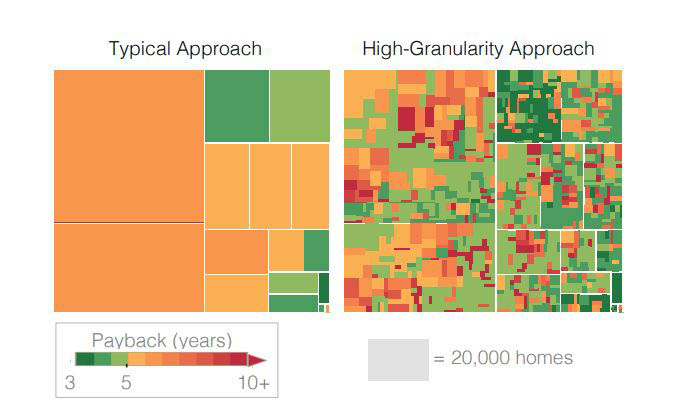NREL Guide Prepares Jurisdictions for Energy-Saving Building Stock Analyses
Feb. 7, 2020 by Laura Beshilas
According to the Energy Information Administration, buildings consume approximately 40% of all the energy used in the United States, including 75% of all electricity. Globally, the amount of urban floor area is expected to double by 2060, adding the equivalent of all the buildings in NYC to the world each month for 40 years. Such growth will compound the challenges cities, states, counties, and utilities face in meeting energy and demand reduction goals. For more information, visit the Architecture 2030 website.
Effective Energy Efficiency Strategies Rely on Good Data
Improved building energy efficiency is key to reducing energy use—now and in the future. Understanding the energy-saving potential of different buildings within a geographical area is an important step toward achieving energy efficiency goals. This can be done through a building stock analysis.
A building stock analysis can help a jurisdiction identify effective strategies for reducing emissions and increasing energy efficiency through building renovations and retrofits, which can in turn reduce utility bills. Conducting such an analysis helps researchers and decision makers determine which types of buildings have the greatest potential for savings, allowing for more targeted work.
Figure 1. The devil’s in the details—A comparison of payback period analyses for wall cavity insulation upgrade in electrically
heated homes in Washington and Oregon shows how tools like ResStock can provide more
actionable results to better inform energy reduction-strategies

Powerful Tools Model Building Energy Savings Potential with Greater Accuracy
ComStock and ResStock are tools for running data-driven, physics-based simulations of U.S. residential and commercial building stocks. Both use large public and private data sets along with modern computing resources to model building energy use and demand on a granular scale.
ComStock models commercial buildings, and ResStock models residential buildings. Together, they can create a more accurate picture of a city’s building stock. The tools can model tens to hundreds of thousands of representative buildings, giving local decision makers a better idea of the energy use and potential changes that could occur in an area.
Figure 1 illustrates the difference between a typical modeling approach and the high-granularity modeling approach used by ComStock and ResStock. The high-granularity approach allows decision makers to more accurately estimate savings potential and better target segments of building stock for the upgrades.
Prepare for a Building Stock Analysis with Seven Simple Steps
The NYC case study identified the following seven steps cities can take to prepare to use the tools for a building stock energy efficiency analysis.
1. Develop Target Questions
Identify specific questions the jurisdiction needs answered through the building stock analysis. Developing targeted questions will guide decisions about what data is collected, how the analysis is performed, which scenarios are modeled, and which stakeholders are included as project partners. This step also includes choosing the audience for the results of the analysis.
2. Identify Partners
Select partners to help collect data, ensure that the model captures the local context, validate the results, implement recommended actions informed by the modeling, and improve project visibility. Local partners may include local firms, utility companies, and nonprofit organizations that are familiar with the city’s building stock.
3. Collect Data
Use local data whenever possible because local context can help improve model accuracy. Data should include building type and location, building stock geometry, building stock characteristics, energy consumption, and cost (of energy and purchase/labor). To learn about the available data sources for building stock analysis in NYC, see Table 1 in Preparing for a City-Scale Building Energy Upgrade Analysis: A Case Study for New York City.
4. Establish Scenarios
Determine which sectors, technologies, and policy scenarios should be analyzed to answer the target questions based on the jurisdiction.
5. Define Metrics
Establish appropriate metrics (related to cost-effectiveness, energy savings, and other health and environmental factors) for evaluation. This will enable the modeling outcomes to answer the target questions.
6. Plan a Results Presentation
Present key stakeholders with actionable results that are most useful in developing and implementing an energy efficiency strategy.
7. Identify Gaps
Work with NREL to determine what gaps are present in the building stock modeling capabilities that need to be updated for future scenario modeling.
Additional Resources
NREL Releases Building Stock Analysis Case Study for New York City
ResStock – Targeting Energy and Cost Savings for U.S. Homes
New York City’s Roadmap to 80x50: NYC’s goal to reduce citywide greenhouse gases 80% by 2050
Contact
What are your city, state, county, or utility energy and demand reduction goals? To learn more about how building stock analysis can help, contact resstock@nrel.gov for residential building stock questions or comstock@nrel.gov for commercial building stock questions.
Share
